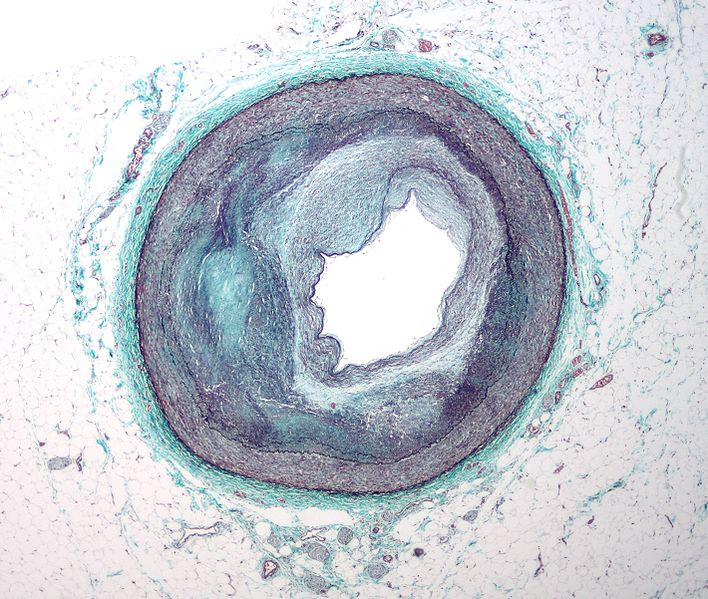Seeing heart attacks before they happen
Interview with
Heart disease is the commonest cause of death in the UK. It happens when the coronary arteries that carry blood to the heart itself become furred up. Luckily, nowadays, doctors can re-open narrowed arteries and prevent them from closing up again by inserting metal cages called stents.  But knowing where to put the stent - in other words identifying the regions of the damaged blood vessel that are at greatest risk of blocking and causing a heart attack - can be very difficult. Now Ramzi Khamis, a British Heart Foundation cardiologist at Imperial College, has found a way to make these danger zones light up so doctors can see then, by using an antibody that glows, as he explained to Chris Smith...
But knowing where to put the stent - in other words identifying the regions of the damaged blood vessel that are at greatest risk of blocking and causing a heart attack - can be very difficult. Now Ramzi Khamis, a British Heart Foundation cardiologist at Imperial College, has found a way to make these danger zones light up so doctors can see then, by using an antibody that glows, as he explained to Chris Smith...
Ramzi - Some of these narrowings, which are called plaques, can rupture and when these plaques rupture, they cause a blood clot to form and then the blood clot causes obstruction in the artery, which then stops the heart muscle from getting enough blood and, therefore, enough oxygen and you end up having a heart attack. So the challenge is to identify which of these plaques are going to rupture and cause a heart attack, and up till now this has been a very challenging field.
Chris - And, of course, the reason for being interested in identifying which of these plaques might need intervention is that we know do have ways of going in and doing things to the inside of arteries to unclog them, open them up, and stabilize them, which we didn't before but, if we don't know where to do that, we can't really solve the problem?
Ramzi - That's absolutely right, Chris. With the current technology that just looks at what the artery looks like, this is still not good enough and, therefore, developing a way of identifying these hot areas is really, really important.
Chris - But these lesions are inside blood vessel, inside the person, so how can you see what's going on in the wall of the blood vessel inside a person?
Ramzi - This is the great advantage of using what we call molecular imaging. We've developed an antibody against this heavily oxidised LDL and we've attached a fluorescent marker to that and then we injected that into animals that mimic the disease that humans have which is hardening of the arteries (atherosclerosis). These antibodies home into where there are high levels of these oxidised LDL molecules and then you can visualise that using a special camera. And you can do that either in the whole body of the animal or you can do it by using a catheter that you can thread through inside the artery and you can look at these deposits from inside the artery, which will hopefully be the technique that we'll be using when we take this work further into humans.
Chris - And when you do this, do you actually find it flagging up areas of the walls of arteries which, when you look later using other techniques like looking down the microscope, do seem to have areas that look prone to rupturing.
Ramzi - Yes, absolutely. So when we look more closely at those areas that light up with our technique, you can see these areas have a heavy load of white blood cells, which are called macrophages, that congregate in areas of dangerous plaque. And we've also taken this forward when we stain atherosclerotic sections, which are taken from people who have had atherosclerosis or hardening of the arteries, you can see similar patterns as well.
Chris - This strongly suggests then you have got something which can home in on these hot spots? You would traditionally go in and what - open up the artery with a balloon and then and put one of these wire cages, these stents in there to hold the artery open?
Ramzi - Well yes, that would be one thing to do but, as technology moves forwards, there would be maybe other ways of treating that part of the artery without even having to put in one of these stents. One of the the things we are working on is attaching therapeutic and molecule to the antibody itself so that, as the antibody homes in to where the dangerous area of atherosclerosis is, it will also deliver a drug to that site in a very specific manner.
Chris - And are we far away? As in how long have I got to survive without having an MI (a heart attack) before I can be the beneficiary of this?
Ramzi - Well Chris, that all depends on how well our next bit of work goes. As you know, in science, things are unpredictable but if you give us at least five years, hopefully, we'll be at a stage where we can try and recruit you as our first human patient, if you are interested? And it's also...
Chris - I'd prefer to be the second actually... It's always good to be second isn't it because then the first poor guy finds out what the pitfalls are?
Ramzi - Well yes absolutely... I very much would encourage you to keep talking to us and we will keep updating you with our progress on how we are getting with getting this into humans.










Comments
Add a comment